Ruleset
Launches a business ruleset.
Supports rulesets with no runtime prompts or runtime prompts with default values. You can add parameters to rulesets for greater flexibility. Use the sample rulesets and POST requests below to help you quickly understand different scenarios when running this job. For details about rulesets, see Designing Business Rulesets.
Using this REST API requires prerequisites, such as understanding how to use jobs. See Prerequisites. Be sure that you understand how to use jobs as described in Managing Jobs. For information about creating rulesets, see Designing with Calculation Manager.
Required Roles
Service Administrator, Power User (if Rule Launch access is granted)
Request
Supported Media Types: application/json
Parameters
The following table summarizes the client request parameters specific to this job. For additional parameters that are common to all jobs, see Execute a Job.
Table 8-11 Ruleset
| Name | Description | Required | Default |
|---|---|---|---|
jobType |
Ruleset or RULESET (both parameters are supported).
|
Yes | None |
jobName |
The name of a business ruleset exactly as is defined in the Planning application. Example: |
Yes | None |
parameters |
No | Default values for the runtime prompts as provided in Calculation Manager will be used. |
Example URL and Payload
https://<BASE_URL>/HyperionPlanning/rest/v3/applications/PS4app1/jobs
{
"jobType":"Ruleset",
"jobName":"Calculate Plan Operating Expenses"
}Example Ruleset Scenarios and POST Requests
These examples based on the Vision application illustrate how to run rulesets with parameters. For each example, review the sample ruleset in Calculation Manager to understand the sample POST request.
Example 1: Ruleset "Revenue Plan" when variables are merged and not hidden
In Revenue Plan, by default the variables are merged and hidden. When variables are hidden, the default values defined in Calculation Manager will be used when executing the ruleset and any values provided in the payload will be ignored.
Sample Ruleset in Calculation Manager
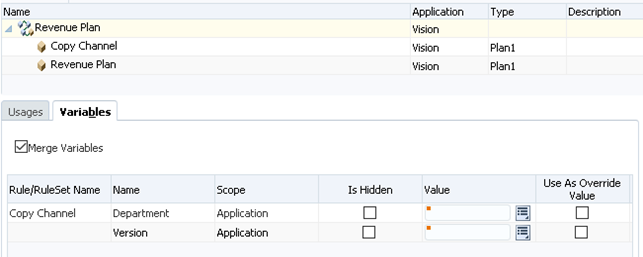
Sample POST request
{
"jobType":"Ruleset",
"jobName":"Revenue Plan",
"parameters":
{
"Version":"Worst Case",
"Department":"No Entity"
}
}Example 2: Ruleset "Revenue Plan" when variables are not merged and not hidden
Sample Ruleset in Calculation Manager
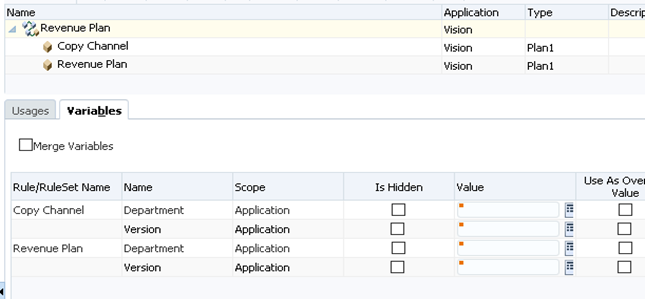
Sample POST request
{
"jobType":"Ruleset",
"jobName":"Revenue Plan",
"parameters":
{
"Copy Channel.Department":"No Entity",
"Copy Channel.Version":"Worst Case",
"Revenue Plan.Department":"New Entity",
"Revenue Plan.Version":"Best Case"
}
}Example 3: Ruleset "Calculate Plan Operating Expenses" with nested ruleset ("Revenue Plan") and variables are merged and not hidden
Sample Ruleset in Calculation Manager
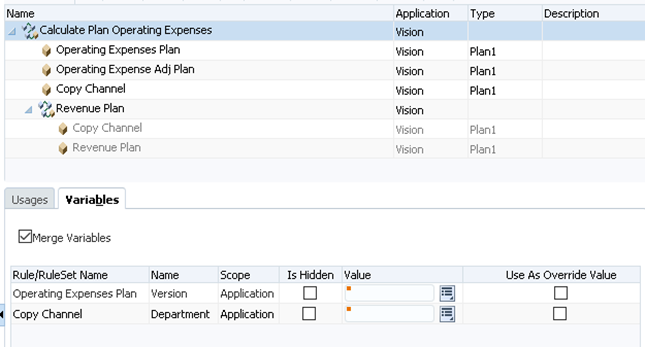
Sample POST request
{
"jobType":"Ruleset",
"jobName":"Calulate Plan Operating Expenses",
"parameters":
{
"Department":"Unspecified Entity",
"Version":"Most Likely"
}
}Example 4: Ruleset "Calculate Plan Operating Expenses" with a nested ruleset ("Revenue Plan") and variables that are not merged and not hidden
Sample Ruleset in Calculation Manager
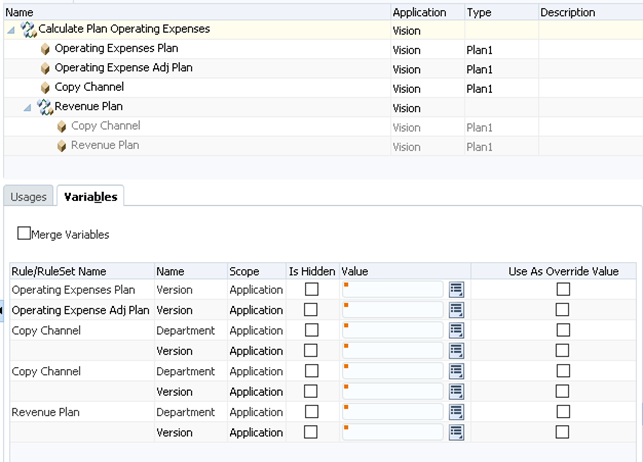
Sample POST request
In this example, the same rule, Copy Channel, appears twice – once under Calculate Plan Operating Expenses, and once under Revenue Plan. This demonstrates how to provide the variables with their fully qualified paths.
{
"jobType":"Ruleset",
"jobName":"Calculate Plan Operating Expenses",
"parameters":
{
"Operating Expenses Plan.Version":"Most Likely",
"Operating Expense Adj Plan.Version":"What If",
"Copy Channel.Department":"Unspecified Entity",
"Copy Channel.Version":"Working",
"Revenue Plan.Copy Channel.Department":"New Entity",
"Revenue Plan.Copy Channel.Version":"Best Case",
"Revenue Plan.Revenue Plan.Department":"No Entity",
"Revenue Plan.Revenue Plan.Version":"Worst Case"
}
}Optionally, you can provide the sequence indexes in the paths, as shown below.
{
"jobType":"Ruleset",
"jobName":"Calculate Plan Operating Expenses",
"parameters":
{
"(1)Operating Expenses Plan.Version": "Most Likely",
"(2)Operating Expense Adj Plan.Version": "What If",
"(3)Copy Channel.Department": "Unspecified Entity",
"(3)Copy Channel.Version": "Working",
"(4.1)Revenue Plan.Copy Channel.Department": "New Entity",
"(4.1)Revenue Plan.Copy Channel.Version": "Best Case",
"(4.2)Revenue Plan.Revenue Plan.Department": "No Entity",
"(4.2)Revenue Plan.Revenue Plan.Version": "Worst Case"
}
}Example 5: Ruleset "Revenue Plan" with variables that are merged and not hidden
This example shows two Revenue Plan rules within a ruleset. This demonstrates how to differentiate the variables when there are multiple variables with the same paths within the same parent in the ruleset.
Sample Ruleset in Calculation Manager
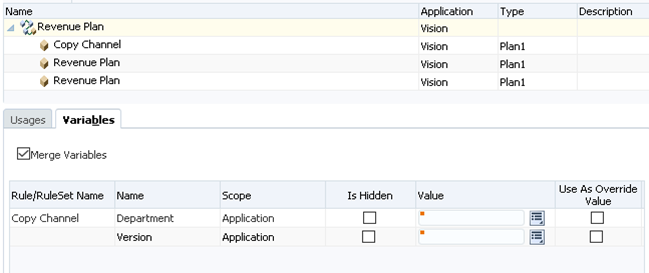
Sample POST request
{
"jobType":"Ruleset",
"jobName":"Revenue Plan",
"parameters":
{
"Version":"Worst Case",
"Department":"New Entity"
}
}Example 6: Ruleset "Revenue Plan" with variables that are not merged and not hidden
This example shows two Revenue Plan rules within a ruleset. This demonstrates how to differentiate the variables when there are multiple variables with the same paths within the same parent in the ruleset.
Sample Ruleset in Calculation Manager
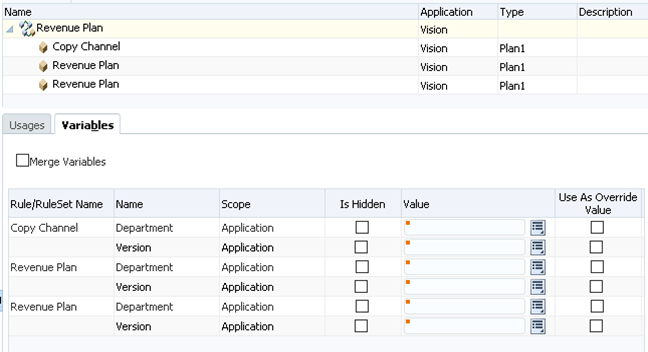
Sample POST request
{
"jobType":"Ruleset",
"jobName":"Revenue Plan",
"parameters":
{
"(1)Copy Channel.Department":"No Entity",
"(1)Copy Channel.Version":"Worst Case",
"(2)Revenue Plan.Department":"New Entity",
"(2)Revenue Plan.Version":"Best Case",
"(3)Revenue Plan.Version":"What If",
"(3)Revenue Plan.Department":"Unspecified Entity"
}
}